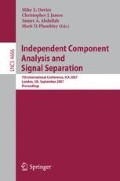Abstract
In this paper, we are interested in the separation of audio sources from their instantaneous or convolutive mixtures. We propose a new separation method that exploits the sparsity of the audio signals via an ℓ p -norm based contrast function. A simple and efficient natural gradient technique is used for the optimization of the contrast function in an instantaneous mixture case. We extend this method to the convolutive mixture case, by exploiting the property of the Fourier transform. The resulting algorithm is shown to outperform existing techniques in terms of separation quality and computational cost.
Access this chapter
Tax calculation will be finalised at checkout
Purchases are for personal use only
Preview
Unable to display preview. Download preview PDF.
References
Cardoso, J.F.: Blind signal separation: statistical principles. Proceedings of the IEEE 86(10), 2009–2025 (1998)
Belouchrani, A., Abed-Meraim, K., Cardoso, J.-F., Moulines, E.: A blind source separation technique using second-order statistics. IEEE T-SP 45(2) (1997)
Belouchrani, A., Amin, M.G.: Blind source separation based on time-frequency signal representations. IEEE Transactions on Signal Processing 46(11) (1998)
Abed-Meraim, K., Xiang, Y., Manton, J.H., Hua, Y.: Blind source separation using second order cyclostationary statistics. IEEE T-SP 49(4), 694–701 (2001)
Yilmaz, O., Rickard, S.: Blind separation of speech mixtures via time-frequency masking. IEEE Transactions on Signal Processing 52(7), 1830–1847 (2004)
Pham, D.T., Cardoso, J.F.: Blind separation of instantaneous mixtures of non stationary sources. IEEE Transactions on Signal Processing 49, 1837–1848 (2001)
Smith, D., Lukasiak, J., Burnett, I.S.: An analysis of the limitations of blind signal separation application with speech. Signal Processing 86(2), 353–359 (2006)
Cichocki, A., Amari, S.: Adaptive Blind Signal and Image Processing. ch. 2. Wiley & Sons, Ltd, UK (2003)
Zibulevsky, M.: Sparse source separation with relative Newton method. In: Proc. ICA, pp. 897–902 (April 2003)
Pham, D.T., Garat, P.: Blind separation of mixture of independent sources through a quasi-maximum likelihood approach. IEEE T-SP 45(7), 1712–1725 (1997)
Murata, N., Ikeda, S., Ziehe, A.: An approach to blind source separation based on temporal structure of speech signals. Neurocomputing 41(1-4), 1–24 (2001)
Pham, D.T., Serviére, C., Boumaraf, H.: Blind separation of convolutive audio mixtures using nonstationarity. In: Proc. ICA, Nara, Japan, pp. 981–986 (April 2003)
Albouy, B., Deville, Y.: Alternative structures and power spectrum criteria for blind segmentation and separation of convolutive speech mixtures. In: Proc. ICA, Nara, Japan, pp. 361–366 (April 2003)
Parra, L., Spence, C.: Convolutive blind separation of non-stationary sources. IEEE Transactions on Speech and Audio Processing 8(3), 320–327 (2000)
Author information
Authors and Affiliations
Editor information
Rights and permissions
Copyright information
© 2007 Springer-Verlag Berlin Heidelberg
About this paper
Cite this paper
Aïssa-El-Bey, A., Abed-Meraim, K., Grenier, Y. (2007). Blind Audio Source Separation Using Sparsity Based Criterion for Convolutive Mixture Case. In: Davies, M.E., James, C.J., Abdallah, S.A., Plumbley, M.D. (eds) Independent Component Analysis and Signal Separation. ICA 2007. Lecture Notes in Computer Science, vol 4666. Springer, Berlin, Heidelberg. https://doi.org/10.1007/978-3-540-74494-8_40
Download citation
DOI: https://doi.org/10.1007/978-3-540-74494-8_40
Publisher Name: Springer, Berlin, Heidelberg
Print ISBN: 978-3-540-74493-1
Online ISBN: 978-3-540-74494-8
eBook Packages: Computer ScienceComputer Science (R0)

